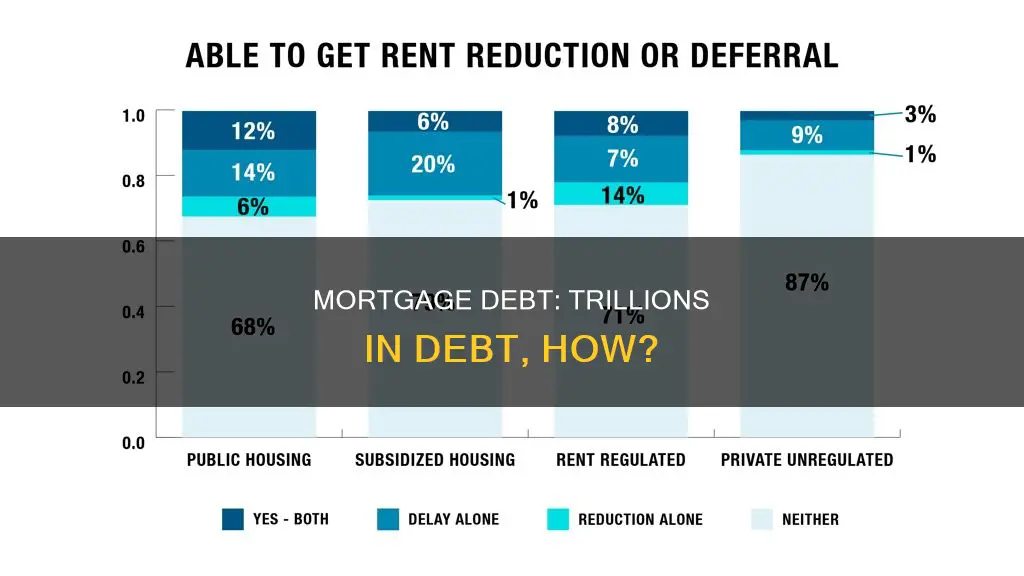
The global debt of $315 trillion is a staggering amount, and household debt, including mortgages, is a significant component of this figure. In the US, mortgage debt has been on a steady rise, with total household debt standing at $17.5 trillion as of Q4 2023, of which mortgage debt accounts for $12.25 trillion. This increase in mortgage debt has been attributed to various factors, including low-interest rates, easy credit conditions, and housing market speculation. The subprime mortgage crisis, which began in 2006, also played a significant role in increasing mortgage debt, as homeowners refinanced their homes at lower interest rates or took out second mortgages to finance consumer spending. Additionally, the COVID-19 pandemic contributed to increased public debt due to the need for more significant funding for programs and services.
| Characteristics | Values |
|---|---|
| Total household debt in the US | $17.5 trillion |
| Total mortgage debt in the US | $12.25 trillion |
| Total credit card debt in the US | $1.13 trillion |
| Total auto loan debt in the US | $1.61 trillion |
| Global debt | $315 trillion |
| Global GDP | $109.5 trillion |
| EM debt-to-GDP ratio | 257% |
| US debt in 1990 | $3.3 trillion |
| US household debt in 1974 | $705 billion |
| US household debt in 2000 | $7.4 trillion |
| US household debt in 2008 | $14.5 trillion |
| US mortgage debt in 2008 | $10.5 trillion |
What You'll Learn

The subprime mortgage crisis
- Loose lending standards and the proliferation of risky mortgages: Lenders offered high-risk mortgages to borrowers with weak credit histories, often referred to as subprime loans. These loans had higher interest rates than traditional mortgages. The lending standards became so relaxed that "NINJA" loans (no income, no job, no assets) emerged during this period.
- Housing speculation and increasing housing demand: The availability of subprime loans fuelled a housing boom as more first-time homebuyers entered the market. This led to increased housing demand, especially in areas with tight supply, and expectations of further price gains.
- Misjudgment of risk by investors and financial institutions: The risks associated with mortgage-backed securities (MBSes) were largely ignored by investors and financial institutions. The steady rise in the value of MBSes created a false sense of security and profitability.
- Government policies: Policies aimed at expanding homeownership, such as federally mandated goals, contributed to lax lending standards and unsustainable housing price increases.
- Faulty financial models: The finance industry offered low-interest rates and high approval rates for subprime mortgage consumers due to faulty financial models.
As interest rates rose and access to credit became more challenging, many subprime borrowers struggled to make loan payments. This led to a sharp increase in mortgage defaults, with many homeowners facing foreclosure. The collapse of the housing market caused the value of MBSes to plummet, resulting in significant financial losses and a cascading crisis. The downward spiral in house prices also fuelled a recession by lowering construction, reducing wealth, decreasing consumer spending, and impairing the ability of financial firms to lend and raise funds.
Mortgage Fraud: A Common and Costly Crime
You may want to see also

Housing and credit bubbles
Easy access to credit, often with lower underwriting standards, is a critical factor in the formation of housing bubbles. Lenders, driven by Wall Street's demand for high-yielding structured mortgage-backed securities (MBS), relax their lending standards, making it easier for buyers to obtain mortgages. This, coupled with unrealistic and unsustainable home price appreciation estimates, encourages buyers to engage in speculative and risky behaviour.
The mid-2000s housing bubble in the US is a notable example, caused by money inflows into housing markets and loose lending conditions. Low-interest rates, relaxed lending standards, and low down payment requirements encouraged people to borrow beyond their means, leading to a widespread housing bubble that contributed to the Great Recession.
Housing bubbles can have far-reaching consequences, affecting communities and the overall economy. When the bubble eventually bursts due to excessive risk-taking and pervasive price speculation, homeowners may struggle to pay off their mortgages, turning to various programs or even retirement accounts to remain in their homes. The economic fallout from housing bubbles can be challenging to manage, as policymakers must decide on the appropriate response to mitigate the impact.
The Mortgage Industry: A Giant in the Financial World
You may want to see also

Rising household debt
The housing bubble, which began in the early 2000s, played a significant role in the increase in mortgage debt. Low interest rates and easy credit conditions fuelled both the housing and credit markets, leading to a surge in borrowing and spending. Consumers assumed unprecedented debt loads, with US household debt as a percentage of annual disposable personal income reaching 127% at the end of 2007, compared to 77% in 1990. The ability to obtain loans easily, coupled with stagnant wage growth, contributed to the increasing debt burden.
The subprime mortgage crisis further exacerbated the issue. As housing prices began to decline, many investors defaulted on their mortgages, leading to significant losses for financial institutions. The crisis spread beyond the housing market, impacting other sectors of the economy. This resulted in a balance sheet recession, similar to debt deflation, as consumers started paying down their debts, which reduced their consumption and slowed the economy.
The impact of rising household debt extends beyond the financial sector. As debt levels increase, financially vulnerable individuals may face higher credit risks, potentially leading to delinquency and negative consequences for their long-term financial health. Additionally, high levels of household debt can have macroeconomic implications, influencing interest rates and the overall economic growth of a country.
Addressing the issue of rising household debt requires a comprehensive approach that includes financial education, responsible lending practices, and policies that support debt management and financial stability for individuals and families.
Mortgage Servicing Transfers: A Common Occurrence for Homeowners
You may want to see also

Increased mortgage originations
One of the factors contributing to the trillions of dollars in mortgage debt is the increase in mortgage originations. This includes new mortgages and refinances, which added $394 billion in the fourth quarter of 2023 alone. The total mortgage loan balances in the US reached $12.25 trillion in the same quarter, with the total number of mortgage accounts increasing to 52.9 million. This represents a rise in mortgage debt per borrower, with the average standing at $258,167 in the fourth quarter of 2023.
The increase in mortgage originations can be attributed to various factors, including low interest rates, easy credit conditions, and housing market dynamics. From 2001 to 2007, US mortgage debt nearly doubled, with the amount of mortgage debt per household rising by more than 63%. This was influenced by the housing bubble, which made it easier for homeowners to refinance their homes at lower interest rates or take out second mortgages. Additionally, consumers were saving less and both borrowing and spending more, contributing to the increase in mortgage debt.
The housing bubble was more prominent in coastal areas, where geographical restrictions or land use limitations made it challenging to build new housing. This resulted in a surge of investors entering the market, driving up demand and prices. The median home price to median household income ratio, a key indicator of the ability to buy a house, rose from 2.9 to 4.6 between 1980 and 2006. This increase in housing prices, coupled with stagnant wages, further contributed to the rise in mortgage debt.
The easy credit conditions and low interest rates also played a significant role in the increase in mortgage originations. Various loan types, including mortgages, were readily available to consumers, leading them to assume unprecedented debt loads. The financial innovation of mortgage-backed securities (MBS) enabled global institutions and investors to invest heavily in the US housing market. However, as housing prices eventually declined, these institutions reported significant losses, and the crisis spread beyond the housing market to other sectors of the economy.
The increase in mortgage originations, driven by a combination of factors, has contributed significantly to the trillions of dollars in mortgage debt. The interplay of economic conditions, consumer behaviour, and market dynamics has led to a substantial rise in mortgage debt per borrower and the overall mortgage debt in the United States.
MyFICO Scores: How Close to Mortgage Eligibility?
You may want to see also

Higher home prices
The years preceding the 2008 financial crisis saw a significant rise in housing prices, with the price of the typical American house increasing by 124% between 1997 and 2006. This period, known as the housing bubble, was characterized by higher rates of household debt, lower savings rates, and a belief that housing prices would continue to rise indefinitely. The bubble eventually burst, leading to the collapse of the subprime mortgage industry and a subsequent financial crisis.
During the housing bubble, easy credit and low-interest rates encouraged many borrowers to take out adjustable-rate mortgages. These loans offered below-market interest rates for an initial period, followed by market rates for the remainder of the term. However, as housing prices began to fall, borrowers found it increasingly difficult to refinance their mortgages, leading to a rise in mortgage defaults.
In recent years, higher mortgage rates have continued to impact housing market activity. Elevated mortgage rates, combined with rising home prices, have made housing less affordable for many potential buyers. This has resulted in a lag in existing home inventory as homeowners with low mortgage rates are reluctant to move. The shortage of homes on the market contributes to persistently high home prices, creating a cycle that further impacts housing affordability.
While higher mortgage rates can slow home price appreciation, the presence of other factors, such as a strong economy and high inflation, can offset this effect. Additionally, the current acute housing supply shortage may also slow the deceleration of home price appreciation, leading to continued challenges in housing affordability.
Blend's Mortgage Revolution: Streamlining the Home Loan Process
You may want to see also
Frequently asked questions
As of the fourth quarter of 2023, the total mortgage debt in the US stands at $12.25 trillion.
The national debt is composed of distinct types of debt, including mortgage, car loan, and credit card debt. The national debt can be broken down by whether it is non-marketable or marketable and whether it is debt held by the public or the government.
There are several factors that have contributed to the increase in mortgage debt. One factor is the low US interest rates from 2002 to 2004, which contributed to easy credit conditions and fueled the housing bubble. Additionally, the increase in mortgage debt balances could be a sign of a strong economy or higher home prices.
Rising household debt, including mortgages, and higher interest rates can increase credit risk for financially vulnerable individuals. Additionally, during periods of high debt, consumers tend to pay down their debt, which reduces their consumption and slows down the economy.







